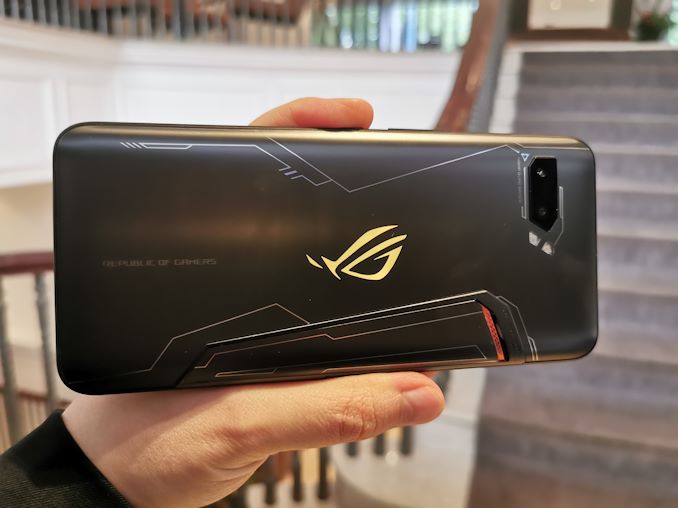The ASUS ROG Phone II Review: Mobile Gaming First, Phone Second
by Dr. Ian Cutress on September 30, 2019 11:00 AM EST- Posted in
- Mobile
- Asus
- Qualcomm
- Smartphones
- ROG
- RGB
- Snapdragon 855 Plus
- ROG Phone II
Conclusions
In the past, we’ve had two very distinct markets at play: handheld consoles with a dedicated ecosystem for gaming, and smartphones for making calls and doing everything online. Trying to bridge the gap between these two markets typically involves starting with one specific device and working towards the middle: the ASUS ROG Phone II starts with the concept of a phone and works towards a dedicated gaming console.
Is this direction the correct way to go? Handheld consoles work great because the hardware is cheap, the gaming titles are dedicated and optimized, and communities build around them. Smartphones work great because of the wealth of apps built for them integrate a lot of device features and enable both a strong workflow and social media integration. Smartphones don’t work great because the game model is substantially different, and handheld consoles don’t do workflow because the app ecosystem isn’t geared that way. It’s a catch-22 either way.
What ASUS wants to do with the ROG Phone II is build one of the best gaming experiences on Android. If we leave handheld consoles to the side for the moment, and imagine what we want out of smartphone gaming on Android, and the ASUS hits a lot of boxes: a high performance SoC with an tuned OS and high performance mode, strong front facing speakers, a high resolution high refresh-rate display, a long life battery, and accessories to help enable a better user experience. Ultimately, ASUS pitches the ROG Phone II as a gaming platform first, that just happens to take phone calls.
But the crux of it all, for me, is that it all comes down to whether gaming on Android is even a thing worth considering. If that is a thing, then ASUS has produced a great solution for it.
Let me put this into two boxes:
At $899, ASUS has created an impressive flagship smartphone that has a long list of bonus features. Dual front facing speakers, 120 Hz display, 6000 mAh battery, high performance, Wi-Gig, the list goes on: all a user has to put up with is a slightly heavier-than-normal device, that just happens to be a phone as well.
At $899, ASUS has created an expensive handheld console. There’s nothing this device can run that a standard flagship smartphone can’t, and at the end of the day our traditional view of a gaming console revolves around unique experiences. What gaming ASUS does enable is some of the best on the Android market, but it’s expensive when compared to something like the Switch.
Would I recommend the ROG Phone II? It’s a lot of hardware as a smartphone. But even though gaming is the focus of the device, I don’t know anyone who buys a smartphone specifically with gaming in mind. For that, handheld consoles do the job.













75 Comments
View All Comments
Doc Rob - Monday, September 30, 2019 - link
the only reason I do not buy one of the ROG phones is simply I NEED wifi calling on tmobile.. I do no want to try and use other apps etc.. allow the use of voLTE and WIFI calling and it would open the market up for many more consumers.Kishoreshack - Tuesday, October 1, 2019 - link
Volte is enabled & WiFi Calling tooyou might have got wrong memo
TheinsanegamerN - Thursday, December 26, 2019 - link
Not in the USA it isntPeachNCream - Tuesday, October 1, 2019 - link
Alternatively, if you use Skype you can pay a fairly minimal amount of money to get a phone number and that will work both over WiFi and cellular data as a VoIP phone. It may fill your needs and mitigate the need for native WiFi calling support on the device.Kishoreshack - Monday, September 30, 2019 - link
@iancutress Where is the Display Analysis?Very sad you skipped on it
s.yu - Tuesday, October 1, 2019 - link
There's also a ton of mistakes in the spec sheet.It's 128/8GB or 1TB/12GB, there is no 256GB variant but there seems to be a 512GB one.
It's UFS3.0 not 2.1.
There are two C ports, which is highly unique but not noted.
Possibly other mistakes.
Death666Angel - Tuesday, October 1, 2019 - link
Probably some copy-paste issues in the table. And the second USB C port is mentioned on the first page below the picture of the connector.s.yu - Wednesday, October 2, 2019 - link
Yeah it was most certainly noted elsewhere, but the spec sheet should be comprehensive.Kishoreshack - Monday, September 30, 2019 - link
Why there is no display analysisNever seen Anandtech such an important aspect
Kishoreshack - Monday, September 30, 2019 - link
Ian Cutress you should have let Andrei do the display analysis or the review itselfhalf review is never expected from Anandtech